Back to Sidestreet Bannerworks
Click here to find out how your engine can be featured!
.


Vertical boiler
logging tram No. 138
by Carl Weaver
Lexington, Virginia, USA
Photos by the author
February, 2011
The notion for this steam-powered tram originated with my fascination for makeshift, vertical-boiler contraptions built in the late 1800s and early 1900s. Local materials and parts at hand were usually used by the shop to make such a machine.
This was the case with this model. It started out as an ugly brass wall lamp that was nearly trashed when my wife said, "Get rid of it!" Fortunately, the lamp made its way to the shop instead and the main part of the lamp became the basis for the frame of the tram. As proof of its origin, the lamp’s UL safety sticker is still on the bottom of the frame.
The model represents no prototype. It is fabricated from scratchbuilt and-off-the-shelf parts in 1:13.7 scale (7/8"), where the 45mm track it runs on represents 2' gauge.
The main components
The power source is an oscillating steam engine known as a Colin Binnie Steam Motor, purchased from the flea market table at the Diamondhead Steamup in 2002. It is a vertical engine with two opposing cylinders against a single block. It has a rotary-valve as a reverser and requires a separate steam valve to control speed. It incorporates reduction gearing to the final drive, which makes it powerful enough to propel this heavy model on a level track, even when pulling several 7/8" scale cars.
The boiler was also acquired at Diamondhead. It is 2-1/2" in diameter and has twelve flues. It was nicely fabricated by an unknown English craftsman. In addition to the fittings seen in the photographs and listed below, the boiler has a snug-fitting cap with an attached smoke stack, as well as a recessed base to accommodate the flame of the burner.
The burner is a 2-1/8" circular steel pan with a ceramic insert. Gas is fed through a #8 jet into an air tube on the side of the pan. The entire burner assembly was purchased from Forrest Classics of England.
The fuel tank, designed for butane, has a regulator and a standard Ronson filler valve. Its origin is uncertain, but is similar to those once made by Cheddar. Capacity is sufficient for very long runs.
The lubricator is a standard Roundhouse Engineering displacement type device.
The trucks (one powered and one not) are 7/8" scale, non-sprung, placed 12" from pivot to pivot. They are Ozark Miniatures models of Sterlingworth trucks, with cast-metal side frames, a wooden beam, and 18" scale wheels from Gary Raymond.
The drive train consists of the reduction gears incorporated into the frame of the steam motor, followed by a series of gears and chains similar in configuration to those used on the BAGRS Project engine. To ensure that at least four wheels are powered, a chain has been placed between gears on the two axles of the rear truck. This arrangement gives enough traction to pull several cars on a flat surface.
The water tank was originally made by Torry Krutzke for use in modifying an Accucraft MichCal Shay, but was changed by adding a soldered-in bottom to actually hold water. A drain cock and a water outlet fitting were also fitted. Water in the tank is fed by gravity to an electric water pump in the cab.
The water pump is a battery-powered Regner device that has been modified. The circuit board that allowed the pump to be used with a radio control transmitter was removed and the pump motor hotwired directly to a four-AAA battery pack with an on-off switch. Both the pump and battery pack are hidden in the cab. Because the boiler has 12 flues, water level is critical, making the water pump a necessity. Since the pump has a built in check valve, one is not needed at the boiler input fitting.
Working lights are all incandescent and include an Accucraft headlight, side markers from Ozark Miniatures, and a fabricated taillight. These are powered by one 9V battery and on-off switch located in the cab.
The cab and platforms were fabricated of walnut and follow no particular style. They are typical of what would have been made with local materials.
Details are from a variety of sources, including scratch built items, Ozark Miniatures cast details, 1:12 scale doll-house accessories, and Accucraft parts. The tram driver, Hazza Lightfoot, is a custom creation by Rob Bennett (Busy Bodies) of England, who made him to specifications after being sent the inside dimensions of the cab and driver’s seat.
Typical operating session
Preparations for a run are almost the same as for any live-steam locomotive. Distilled water is added to the boiler; additional water is added to the tank; the lubricator is drained and filled with steam oil; butane is added to the fuel tank; and all mating surfaces are dowsed with lubricating oil. In addition, steam oil is applied to the two faces of the steam motor upon which the cylinders move.
Lighting the burner is sometimes unpredictable. By temporarily removing the boiler cover and smoke stack, flame jumping from the burner to the top of the boiler can be prevented. Lighting the burner requires very little fuel flow and can be accomplished by putting the lighter flame near one of the air intakes on the jet tube. Once lit, time is needed to heat the ceramic to a glow before making any adjustments to the fuel flow or replacing the boiler cover and smoke stack. The glow can be seen with a mirror by looking down the flues. When this burner is burning properly, it emits a faint purring sound.
The time required to build pressure to 40 psi is very short since there is not much water in the boiler. As soon as pressure is reached, it is necessary to turn on the electric fuel pump. The sight gauge is then watched closely to make sure the pump is keeping up with steam generation. If it is not, it is usually because there is an air bubble in the line from the tank to the pump. The quick disconnect at the boiler water input fitting can be removed and the hose sucked on to prime the line and ensure proper water flow.
Once sufficient water pump flow is noted, the tram can be allowed to move forward by slowly opening the steam valve. As a matter of course, the reverser is always set in the forward position because the sweet spot is very small and sometimes difficult to find. The tram is rarely put into reverse, although, with some fiddling, it can be done. Forward movement usually starts on its own with a little jerking, as condensed water in the lines is blown out the exhaust. Once water has cleared, the motor runs smoothly, although so fast that the cylinders are a blur.
Occasionally during the run, steam oil is squirted on the cylinder mating surfaces. Watching the water level in the sight glass during operation is important. If it is noticed that the pump is not providing enough output, water can be easily added to the boiler via the Goodall valve using a squirt bottle.
When the water pump keeps up with the boiler, running times can exceed 1-1/2 hours because so little fuel is needed to keep the ceramic burner glowing red hot. The limiting factor is, of course, the amount of steam oil in the lubricator. It isn’t known how long the tram will run because the fuel tank has never been allowed to run dry.
One of the cars normally pulled with the tram has a bicycle speedometer in the window, which is adjusted to scale speed by setting it to what it thinks is an actual 18" wheel. It is interesting to note that, at full speed, the tram operates from 5 to 10 scale miles per hour, depending on the number of cars being pulled, which is prototypical.
The tram has won several modeling awards including First Place Overall Show at the 2009 East Coast Large Scale Train Show in York, Pennsylvania.
Here's a video of the engine in action. If, for some reason, it doesn't work, click here.
|
|
|
| Builder | Carl Weaver (USA) |
| Date built | 2003-2004 |
| Gauge | 45 mm (gauge 1) |
| Scale | 1:13.7 (7/8") |
| Boiler | 2-1/2" vertical copper tube with 12 flues |
| Fittings | Safety valve, Goodall valve, steam regulator, sight gauge, pressure gauge, water input quick-disconnect fitting, dummy fire door |
| Fuel | Butane gas |
| Blow-off pressure | 40 psi |
| Cylinders | Two oscillating cylinders in a steam-motor configuration (Colin Binnie steam motor) |
| Reversing gear | Rotary valve |
| Lubricator | Displacement |
| Dimensions | Length, 19-1/2”; width, 5”; height of cab roof above rails, 9” |
| Weight | 10 pounds, 2 ounces |
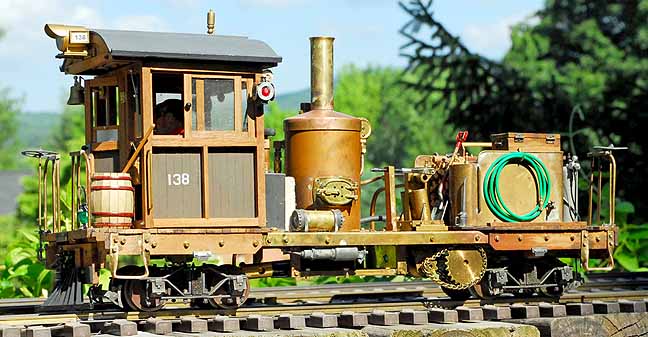
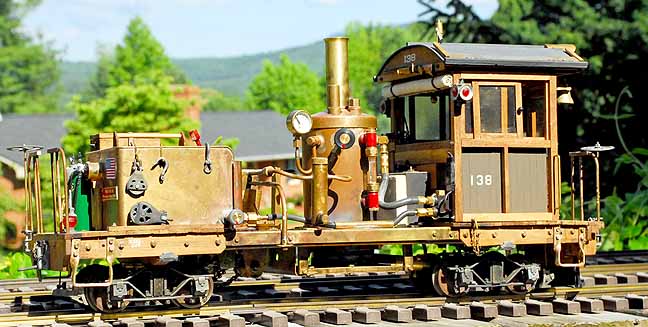

Right: The rear. The well-detailed model exudes character.
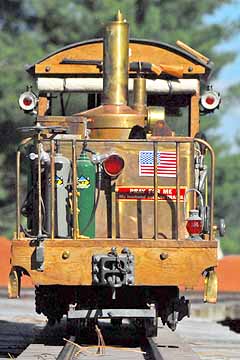
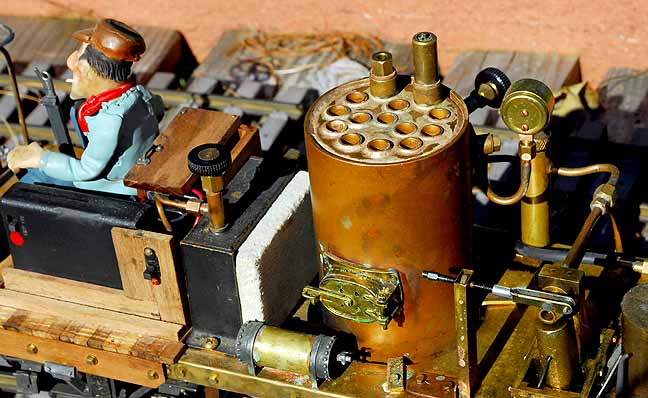

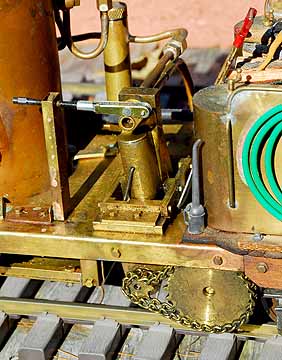
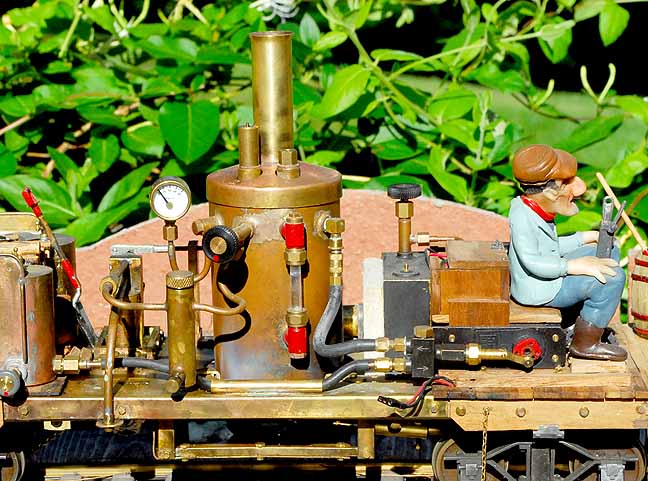

Back to Sidestreet Bannerworks
Click here to find out how your engine can be featured!
This page and its contents
Copyright Sidestreet Bannerworks, 2010